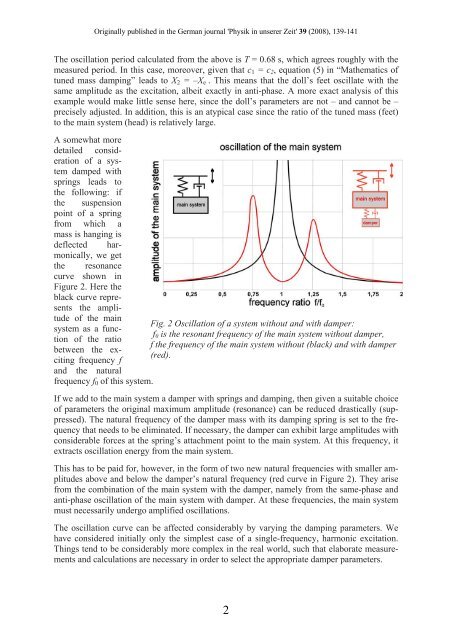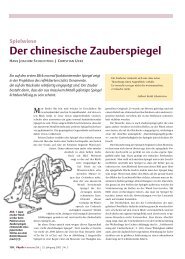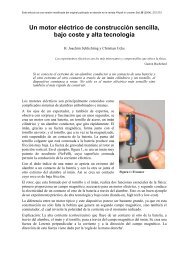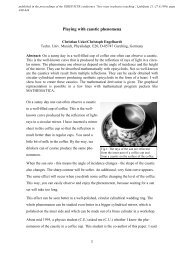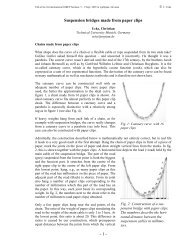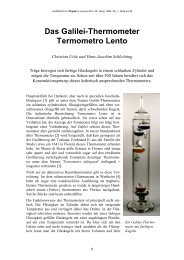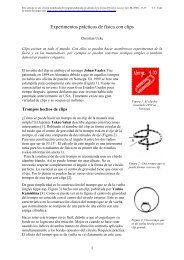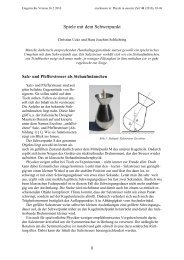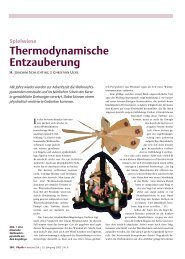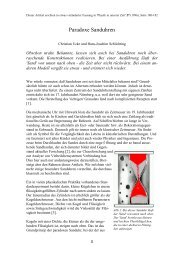Oscillating Dolls and Skyscrapers
Oscillating Dolls and Skyscrapers
Oscillating Dolls and Skyscrapers
Create successful ePaper yourself
Turn your PDF publications into a flip-book with our unique Google optimized e-Paper software.
Originally published in the German journal 'Physik in unserer Zeit' 39 (2008), 139-141<br />
The oscillation period calculated from the above is T = 0.68 s, which agrees roughly with the<br />
measured period. In this case, moreover, given that c 1 = c 2 , equation (5) in “Mathematics of<br />
tuned mass damping” leads to X 2 = –X e . This means that the doll’s feet oscillate with the<br />
same amplitude as the excitation, albeit exactly in anti-phase. A more exact analysis of this<br />
example would make little sense here, since the doll’s parameters are not – <strong>and</strong> cannot be –<br />
precisely adjusted. In addition, this is an atypical case since the ratio of the tuned mass (feet)<br />
to the main system (head) is relatively large.<br />
A somewhat more<br />
detailed consideration<br />
of a system<br />
damped with<br />
springs leads to<br />
the following: if<br />
the suspension<br />
point of a spring<br />
from which a<br />
mass is hanging is<br />
deflected harmonically,<br />
we get<br />
the resonance<br />
curve shown in<br />
Figure 2. Here the<br />
black curve represents<br />
the amplitude<br />
of the main<br />
Fig. 2 Oscillation of a system without <strong>and</strong> with damper:<br />
system as a function<br />
of the ratio<br />
f 0 is the resonant frequency of the main system without damper,<br />
f the frequency of the main system without (black) <strong>and</strong> with damper<br />
between the exciting<br />
frequency f<br />
(red).<br />
<strong>and</strong> the natural<br />
frequency f 0 of this system.<br />
If we add to the main system a damper with springs <strong>and</strong> damping, then given a suitable choice<br />
of parameters the original maximum amplitude (resonance) can be reduced drastically (suppressed).<br />
The natural frequency of the damper mass with its damping spring is set to the frequency<br />
that needs to be eliminated. If necessary, the damper can exhibit large amplitudes with<br />
considerable forces at the spring’s attachment point to the main system. At this frequency, it<br />
extracts oscillation energy from the main system.<br />
This has to be paid for, however, in the form of two new natural frequencies with smaller amplitudes<br />
above <strong>and</strong> below the damper’s natural frequency (red curve in Figure 2). They arise<br />
from the combination of the main system with the damper, namely from the same-phase <strong>and</strong><br />
anti-phase oscillation of the main system with damper. At these frequencies, the main system<br />
must necessarily undergo amplified oscillations.<br />
The oscillation curve can be affected considerably by varying the damping parameters. We<br />
have considered initially only the simplest case of a single-frequency, harmonic excitation.<br />
Things tend to be considerably more complex in the real world, such that elaborate measurements<br />
<strong>and</strong> calculations are necessary in order to select the appropriate damper parameters.<br />
2


